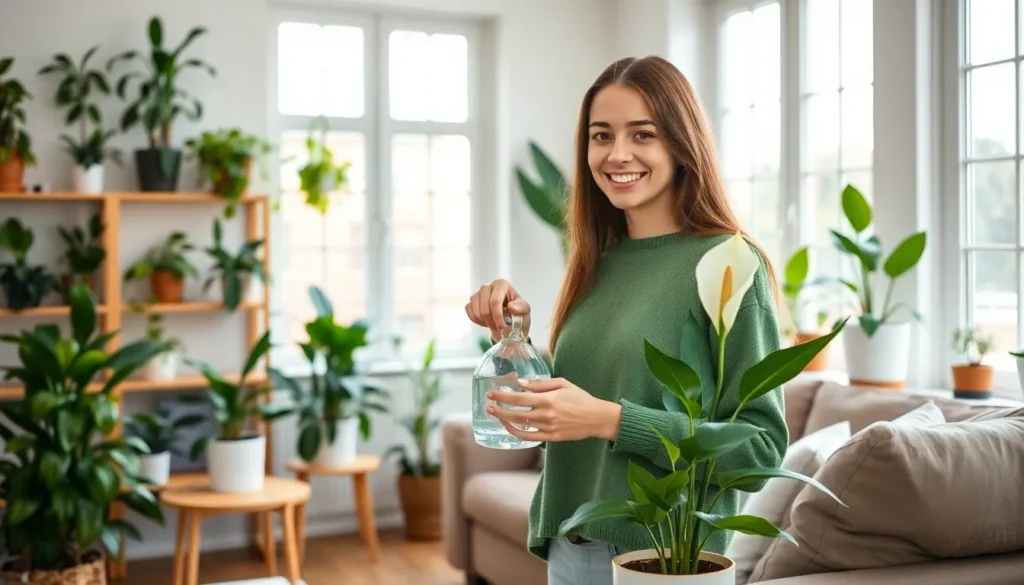We’ve all walked into a room and felt instantly at peace – there’s something magical about spaces filled with lush greenery that transforms our entire mood. Your living room doesn’t just have to be a place where you watch TV or entertain guests; it can become a vibrant sanctuary that breathes life into your daily routine.
Plants aren’t just trendy décor pieces – they’re powerful allies that purify your air, boost your mental health, and create an atmosphere that’s both sophisticated and welcoming. Whether you’re dealing with a cramped apartment or a spacious family room, we’ll show you how the right plants can turn your living space into an Instagram-worthy oasis.
The best part? You don’t need a green thumb to create a stunning plant-filled living room that’ll have your friends asking for decorating tips. Let’s jump into the secrets of choosing, arranging, and caring for plants that’ll transform your space from ordinary to extraordinary.
Choose the Right Plants for Your Living Room Environment
Selecting plants that thrive in your exact living room conditions ensures long-term success and vibrant greenery.
Consider Light Conditions and Window Placement
Bright indirect light works best for most popular houseplants like pothos, snake plants, and rubber trees. We recommend placing these varieties within 3-6 feet of south or west-facing windows where they’ll receive filtered sunlight throughout the day.
Low light areas near north-facing windows or corners away from direct sunlight suit plants like ZZ plants, peace lilies, and Chinese evergreens perfectly. These resilient varieties adapt well to artificial lighting and require minimal natural sunlight to flourish.
Direct sunlight exposure through unfiltered windows can scorch delicate leaves on plants like ferns and begonias. We suggest using sheer curtains or moving light-sensitive plants further from windows to prevent leaf burn while maintaining adequate brightness.
Evaluate Temperature and Humidity Levels
Room temperature consistency between 65-75°F creates ideal growing conditions for tropical houseplants like monstera, philodendrons, and fiddle leaf figs. We’ve found that avoiding placement near heating vents, air conditioning units, or drafty windows prevents temperature stress that can cause leaf drop.
Humidity requirements vary significantly among plant species, with tropical varieties needing 40-60% humidity levels compared to succulents that prefer drier conditions around 30-40%. We recommend using a hygrometer to monitor moisture levels and adding humidifiers or pebble trays near humidity-loving plants.
Seasonal adjustments become necessary as heating systems reduce indoor humidity during winter months while air conditioning can create overly dry conditions in summer. We suggest grouping plants together to create natural humidity pockets and misting varieties like Boston ferns that benefit from increased moisture.
Select Plants Based on Your Maintenance Commitment
Low maintenance options like snake plants, pothos, and spider plants require watering only every 1-2 weeks and tolerate occasional neglect without suffering permanent damage. We recommend these varieties for busy households or first-time plant parents who want beautiful greenery without intensive care routines.
Moderate care plants such as rubber trees, peace lilies, and dracaenas need weekly attention including watering checks, occasional fertilizing, and monthly cleaning of leaves. We find these varieties perfect for plant enthusiasts ready to develop regular care habits while still maintaining manageable routines.
High maintenance specimens like fiddle leaf figs, calatheas, and orchids demand daily monitoring, exact watering schedules, and precise environmental conditions to prevent stress or disease. We suggest starting with easier varieties before advancing to these challenging but rewarding plants that require dedicated attention and experience.
Position Plants Strategically Throughout Your Living Space
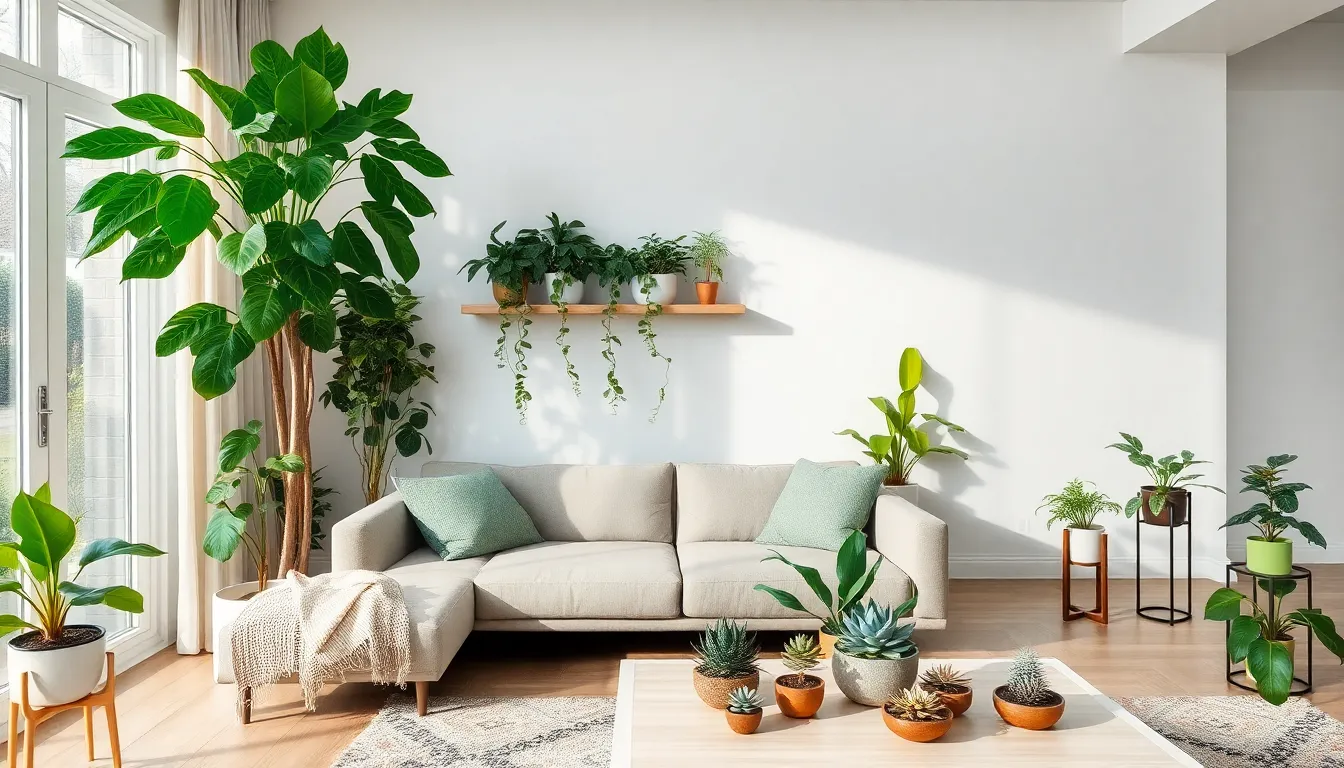
Now that we’ve selected the perfect plants for our conditions, let’s explore how to arrange them for maximum visual impact and healthy growth.
Create Visual Balance with Varying Heights
Group plants in clusters following the “rule of three” to create natural, harmonious arrangements that feel organic rather than forced. We recommend combining plants of different heights, such as pairing tall fiddle leaf figs with shorter bushy plants like pothos or snake plants, to add depth and layered interest throughout our living space.
Mix tall trees with medium and small plants to establish visual flow that draws the eye naturally around the room. Large plants such as rubber plants or palms work beautifully as anchor points, while trailing plants and compact succulents fill in the arrangement with varied textures and forms.
Prune tall plants approaching the ceiling to encourage side branching and maintain proper scale with our furniture. This pruning technique prevents plants from overwhelming the space while promoting healthier, bushier growth that complements our room’s proportions.
Use Corner Spaces for Statement Plants
Position large plants in empty corners to transform unused spaces into stunning focal points that soften harsh angles and architectural lines. Corners make excellent spots for impressive foliage plants like fiddle leaf figs, monstera deliciosa, or bird of paradise that can truly anchor our room visually.
Choose statement plants with dramatic leaves or unique forms to create calming, lush vibes that serve as natural conversation starters. These corner plants should have enough presence to fill vertical space effectively while complementing our existing furniture and decor style.
Ensure large plants fit within a 3×3 feet area to avoid overcrowding and maintain healthy air circulation around the plant. This spacing allows our statement plants to grow properly while preventing them from dominating the entire corner or blocking natural pathways through our living room.
Incorporate Plants on Shelves and Side Tables
Elevate small to medium plants on side tables and coffee tables to give them prominence without creating surface clutter or blocking sight lines. We can use decorative plant stands, wooden stools, or existing furniture to create varying elevations that make each plant visible and part of our overall design scheme.
Place trailing plants on shelves to create eye level greenery that adds texture and visual interest vertically throughout our space. Plants like pothos, string of hearts, or spider plants work particularly well on floating shelves or bookcases where their cascading foliage can drape naturally.
Mix pot styles in various colors, shapes, and materials to complement both our plant arrangement and existing living room decor. Terra cotta pots offer classic appeal, while ceramic planters in coordinating colors can tie together our entire plant display with our furniture and accent pieces.
Select Complementary Plant Containers and Planters
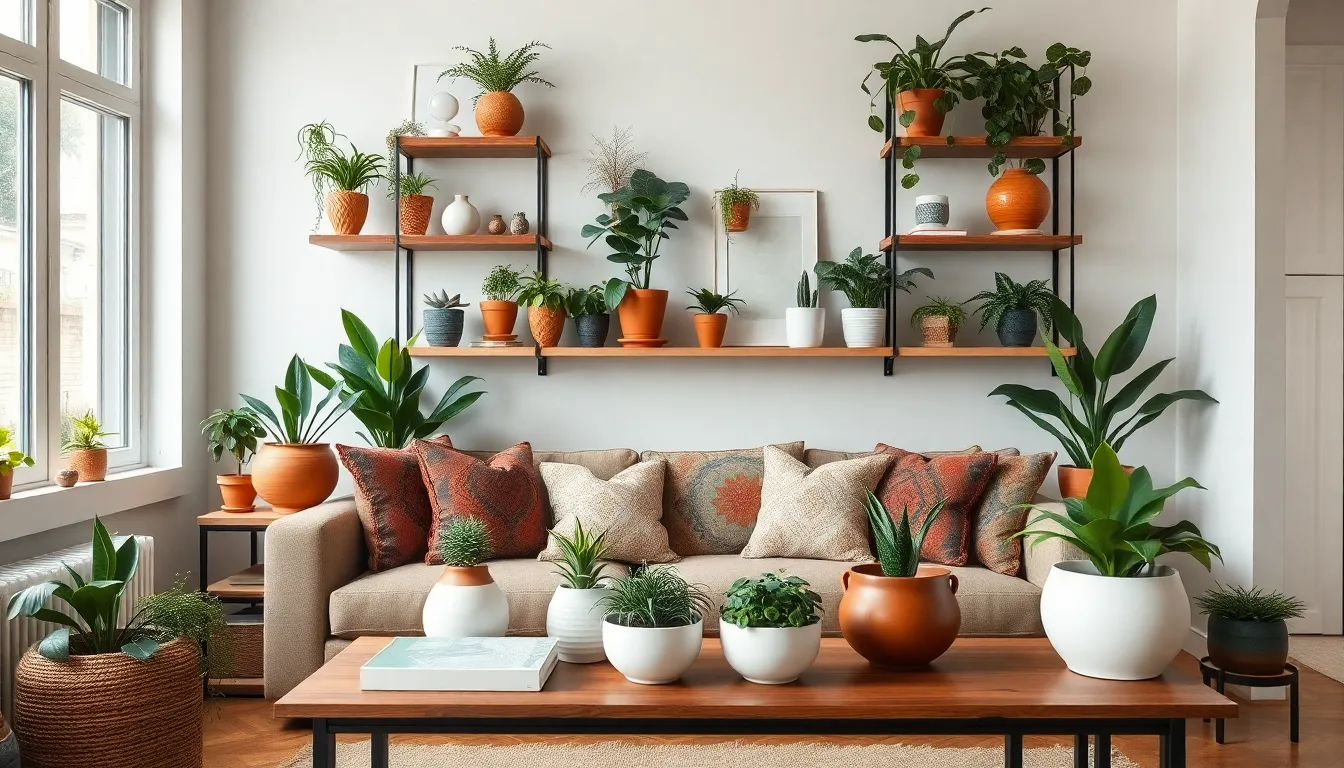
We’ve explored plant positioning strategies, so now let’s focus on containers that elevate your living room’s plant display. The right planters transform greenery from basic houseplants into sophisticated design elements that seamlessly integrate with your existing décor.
Match Pot Styles to Your Living Room Decor
Match your container choices to your living room’s overall aesthetic for a cohesive, intentional look. Vintage crocks and terracotta pots complement eclectic or bohemian interiors perfectly, adding warmth and character to your space. Sleek minimalist planters work exceptionally well in modern or Scandinavian designs, maintaining clean lines and understated elegance.
Glass jars create visual lightness in contemporary spaces while showcasing interesting root systems or layered soil compositions. Thrifted trunks bring rustic charm and conversation-worthy focal points to traditional or farmhouse-style rooms. We recommend mixing different container types strategically rather than using identical pots throughout your space, as this variety prevents your plant display from looking like an afterthought.
Choose Appropriate Sizes for Your Plant Selection
Choose container sizes that complement both your plants and your living room’s proportions. Tall plants like fiddle leaf figs and monsteras require substantial floor planters that can anchor empty corners or fill awkward spaces next to sofas and windows effectively. These larger specimens need containers with enough weight and width to support their mature size without tipping.
Smaller plants work best when grouped in sets of three or other odd numbers on shelves, coffee tables, and plant stands. This arrangement creates natural balance while preventing any single plant from getting lost in your décor. We suggest varying heights within these groupings to add visual interest without overwhelming your furniture or blocking important sightlines.
Size your containers to allow proper root growth while maintaining proportion with your plant’s current and future dimensions. Oversized pots can lead to overwatering issues, while undersized containers restrict healthy development.
Consider Drainage and Plant Health Requirements
Consider drainage as your primary concern when selecting any plant container for your living room. Proper drainage prevents overwatering and root rot, which are the leading causes of houseplant failure in indoor environments. Containers with drainage holes allow excess water to escape naturally, protecting your plants’ root systems.
Use decorative outer pots without drainage by creating a layered system with activated charcoal and pebbles beneath the soil. This method provides adequate moisture control while maintaining your desired aesthetic appeal. Double potting also protects your furniture and flooring from water damage.
Group plants with similar light and moisture requirements in matching or coordinating containers to simplify your care routine. Shade tolerant varieties like pothos and snake plants thrive in low light corners, while sun loving specimens need containers positioned near windows with bright indirect light. This strategic grouping ensures all your plants receive appropriate care while creating visually cohesive plant arrangements throughout your living room.
Design Plant Groupings for Maximum Visual Impact
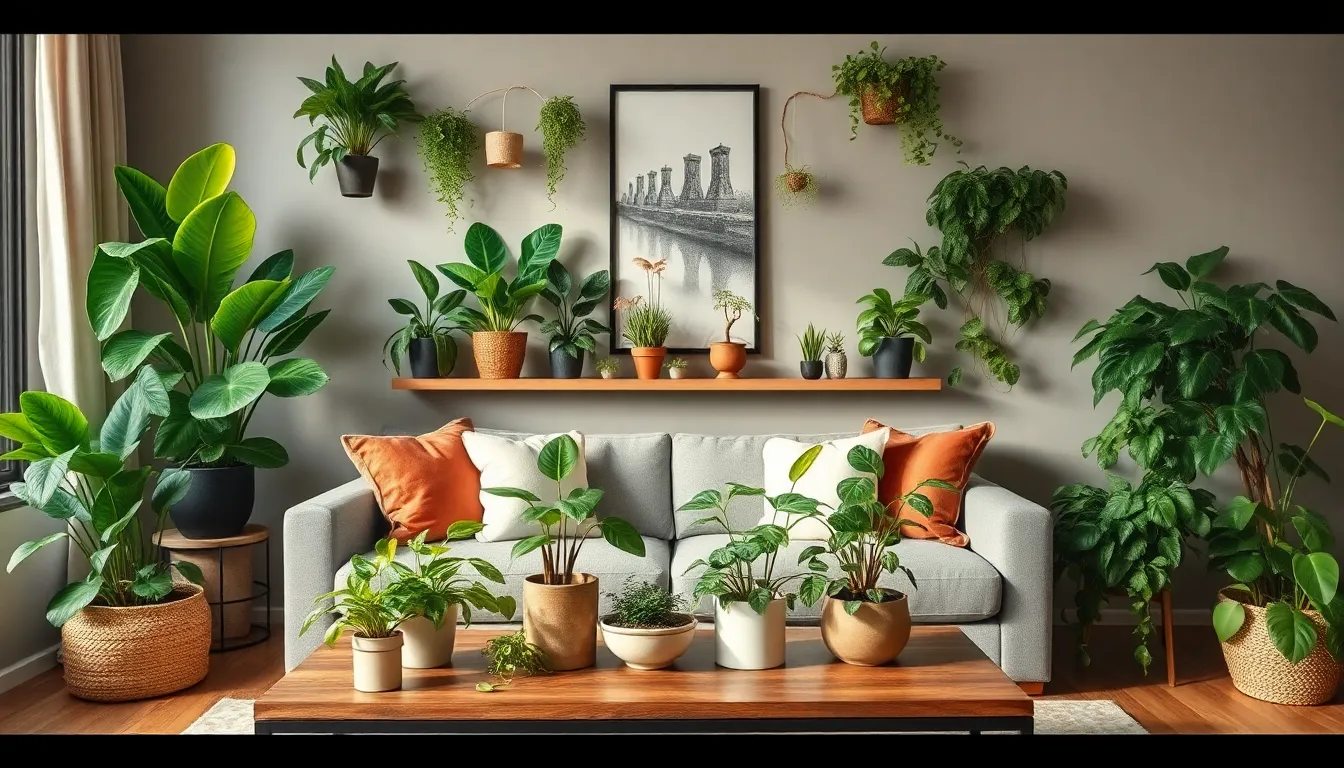
Now that we’ve covered container selection, let’s explore how strategic grouping transforms individual plants into stunning visual displays that command attention and create focal points throughout our living room.
Create Clusters with Different Textures and Colors
Mixing textures prevents monotonous displays that blend into the background and fail to capture visual interest. We achieve ever-changing arrangements by pairing smooth, glossy leaves like those on rubber plants with coarse or textured foliage such as ferns or snake plants. This contrast creates depth and draws the eye naturally across the grouping.
Color variety enhances focal points within our living space through strategic plant selection. Different shades of green ranging from deep emerald to bright lime create natural gradation, while occasional splashes of color from flowering plants like peace lilies or variegated varieties such as prayer plants contribute vibrant accents. These colorful elements serve as natural artwork that changes with the seasons.
Avoiding similar leaf textures ensures each plant maintains its individual character while contributing to the collective display. Plants with identical textures and shapes tend to disappear into each other, creating flat arrangements that lack visual punch.
Use the Rule of Odds for Pleasing Arrangements
Odd numbered groupings create natural harmony that feels organic rather than forced or formal. We group plants in clusters of three or five to achieve this pleasing aesthetic, as research shows odd numbers appear more balanced to the human eye than even arrangements.
Three plant combinations work exceptionally well for most living room spaces without overwhelming smaller areas. We select plants with distinct shapes but balanced proportions to create stylish and relaxed displays that enhance rather than dominate our room’s atmosphere.
Five plant groupings suit larger spaces where we have ample floor area or extended surfaces to accommodate bigger arrangements. These expanded clusters allow for more dramatic height variation and texture mixing while maintaining the natural flow that odd numbers provide.
Mix Trailing and Upright Plant Varieties
Combining growth habits adds layers and movement to our plant arrangements, creating visual interest that static displays simply can’t match. We pair upright species like fiddle leaf figs or snake plants with trailing varieties such as pothos or string of pearls to achieve this ever-changing effect.
Upright plants serve as anchor points that establish height and structure within our groupings. These vertical elements like peace lilies or rubber trees provide stability and draw attention upward, making our ceilings appear higher and our rooms more spacious.
Trailing plants soften harsh lines and add graceful movement that brings life to our arrangements. We position cascading varieties like golden pothos or string of hearts on elevated surfaces within our groupings, allowing their flowing foliage to create natural bridges between different plant heights and fill empty spaces with organic curves.
Incorporate Plants Into Your Existing Furniture Layout
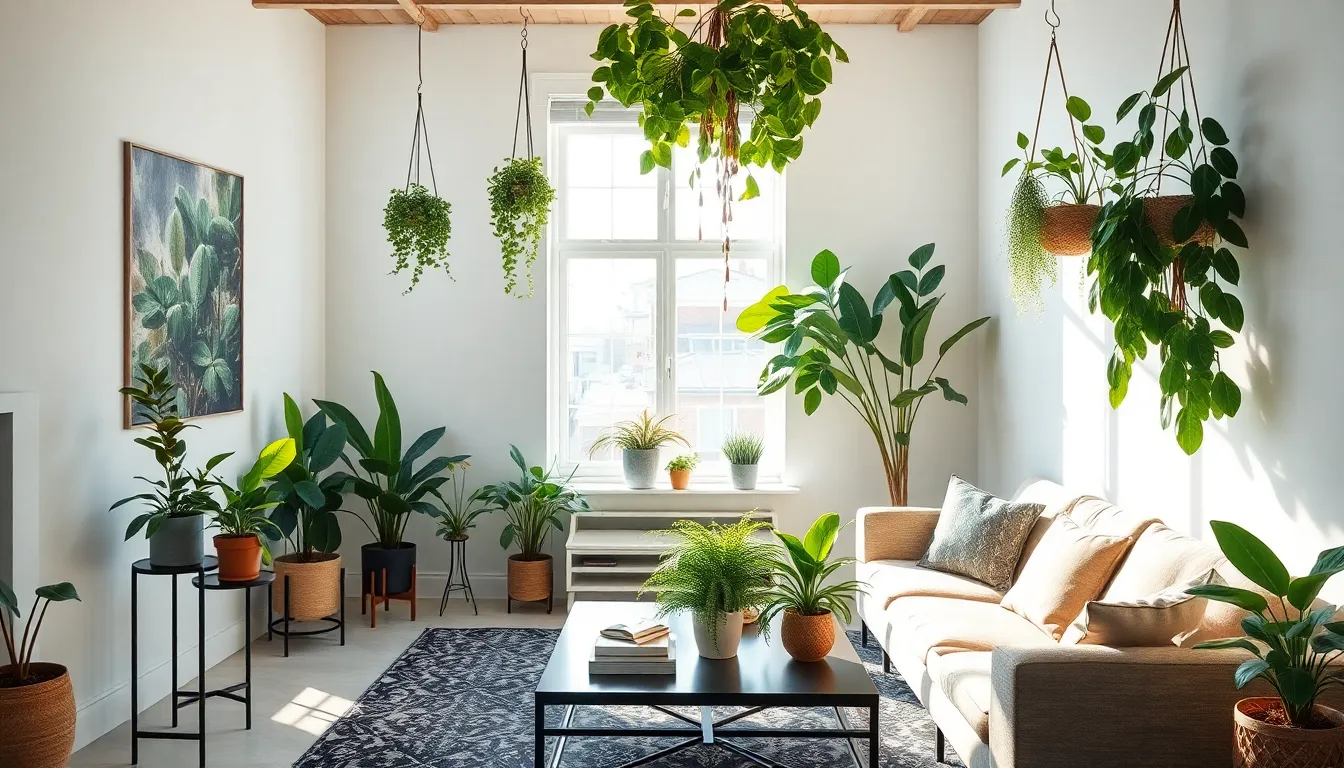
Now that we’ve selected the perfect containers and designed stunning plant groupings, let’s explore how to seamlessly integrate these green elements with your existing furniture arrangement. Strategic placement creates a harmonious flow that enhances both your plants and your living space.
Use Plant Stands to Add Levels and Dimension
Plant stands transform flat surfaces into ever-changing displays that complement your furniture’s varying heights. We recommend employing stands and shelves at different elevations to introduce visual dimension while maintaining balance with your existing pieces. Multi-level arrangements prevent the flatness that occurs when all plants sit at the same height.
Position small plants on furniture that’s at least knee-level high, such as coffee tables or side tables, rather than placing them directly on the floor. This elevation keeps eye movement fluid around the room and creates better integration with your seating arrangements. Mix plant heights strategically by combining tall floor plants with elevated smaller specimens to achieve a layered, professional look.
Varying stand heights also allows us to showcase different plant types effectively. Trailing varieties like pothos work beautifully on taller stands where their vines can cascade, while compact succulents shine on lower surfaces near seating areas.
Position Plants Near Seating Areas for Ambiance
Strategic placement near seating zones creates the most impactful mood enhancement while maintaining practical furniture flow. We suggest situating plants within or around your primary seating areas to boost relaxation and add natural softness to the space. This proximity allows you to enjoy the plants’ calming presence during daily activities.
Avoid shoulder-to-shoulder placement between plants and furniture to maintain comfortable movement and conversation flow. Instead, position plants where they enhance rather than obstruct your furniture’s functionality. Corner spots behind chairs or beside sofas work particularly well for larger specimens.
Group plants using the rule of three by arranging them in odd numbers like three or five to achieve a natural, harmonious aesthetic. This approach creates visual interest without appearing too formal or sparse, perfectly complementing your existing furniture arrangement.
Integrate Hanging Plants for Vertical Interest
Hanging plants maximize vertical space while preserving valuable floor area around your furniture layout. We use wall-mounted shelves and ceiling hooks to draw the eye upward, adding depth without sacrificing surface space needed for daily living. This vertical integration works especially well in smaller rooms where floor space is limited.
Hanging planters excel in corners or above furniture pieces where they contribute to a layered, cozy environment. Position them at varying heights to create visual rhythm that complements your room’s architecture and furniture placement. Choose spots where the plants won’t interfere with foot traffic or furniture use.
Consider the sight lines from your seating areas when selecting hanging plant locations. Plants suspended at eye level from seated positions create intimate green focal points, while higher placements add architectural interest to the room’s upper reaches.
Maintain Your Living Room Plant Collection Successfully
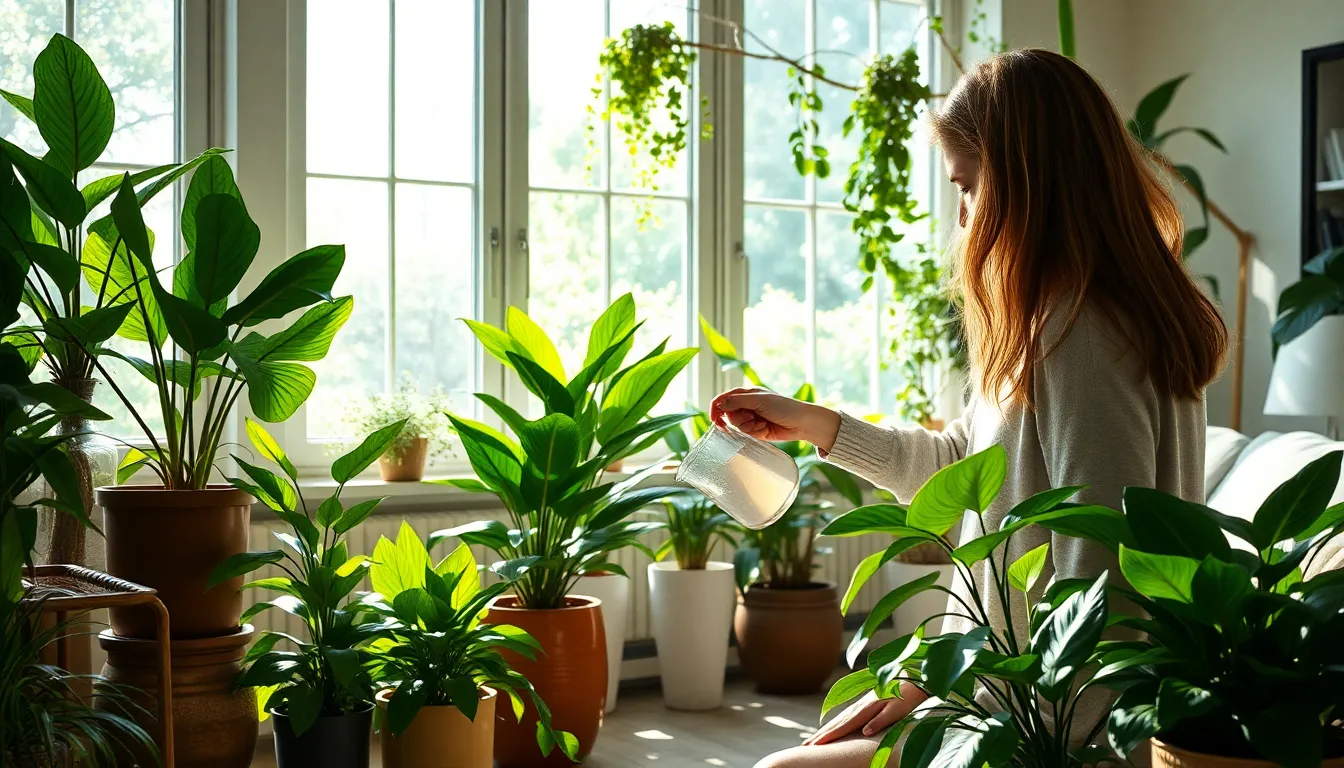
Now that we’ve created our stunning plant displays, we’ll need to master the essential care techniques that keep our greenery thriving year-round.
Establish a Consistent Watering Schedule
Developing a customized watering routine prevents the two most common plant care mistakes: overwatering and underwatering. Most indoor plants prefer soil that remains moist but not soggy, and we should adjust our frequency based on plant type and seasonal changes. Peace lilies thrive when their soil stays consistently moist but never waterlogged, while succulents need completely dry soil between waterings.
Using well-draining pots eliminates the risk of stagnant water that leads to root rot. We can test soil moisture by inserting our finger about two inches deep – if it feels dry, it’s time to water. Creating a weekly schedule and noting each plant’s exact needs helps us maintain consistency without overwhelming ourselves.
Monitor Plant Health and Growth Patterns
Regular observation allows us to catch potential problems before they become serious issues. Yellowing leaves often signal overwatering or nutrient deficiency, while brown, crispy edges typically indicate underwatering or low humidity. We should examine our plants weekly, looking for changes in leaf color, texture, and overall appearance.
Pruning plants like dracaenas prevents overly long foliage and maintains their attractive shape. Removing dead or damaged leaves encourages new growth and prevents disease from spreading. Tracking how our plants respond to light and water helps us make informed adjustments that promote healthy development throughout the seasons.
Rotate Plants for Even Light Distribution
Indoor plants naturally lean toward their light sources, creating uneven growth patterns that can compromise their appearance and health. We should rotate our plants a quarter turn every week to ensure all sides receive equal light exposure. Popular living room plants like pothos, philodendrons, and peace lilies adapt well to varying light conditions but benefit significantly from regular rotation.
Establishing a rotation schedule prevents one-sided growth and reduces the risk of leaf damage from excessive light exposure. Plants positioned near windows or under grow lights especially need consistent rotation to maintain their balanced, symmetrical appearance. This simple practice ensures our plant displays remain visually appealing while promoting healthier growth patterns.
Style Your Living Room With Plants for Different Seasons
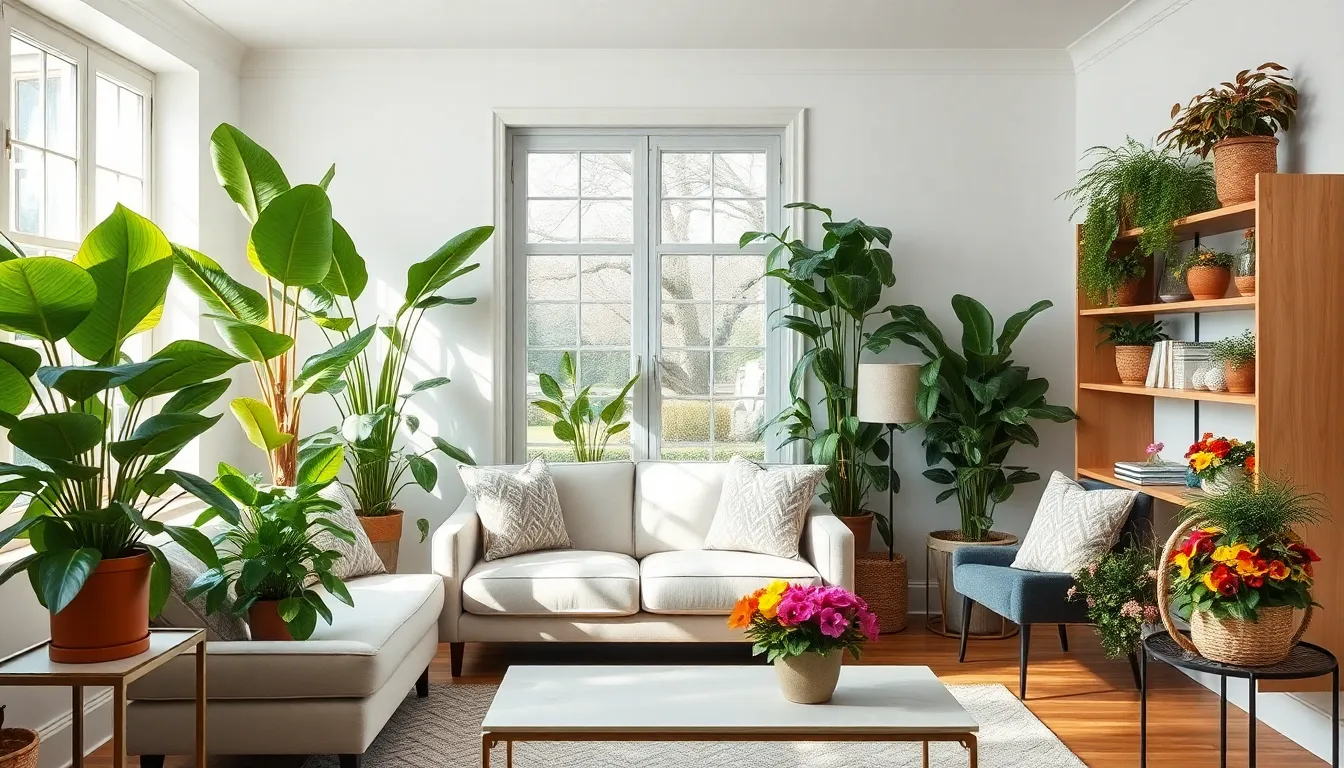
Creating a seasonally adaptive plant display keeps your living room fresh and vibrant throughout the year. We’ll show you how to transform your space with strategic arrangements that reflect each season’s unique character.
Adapt Plant Arrangements for Seasonal Changes
Group plants in odd numbers to create natural harmony and visual balance in your seasonal displays. Clusters of three or five plants work exceptionally well for maintaining visual interest while allowing flexibility for seasonal updates.
Position tall statement plants like fiddle leaf figs or Monstera deliciosa in empty corners to serve as natural focal points. These large plants act as living room dividers while filling dead space with lush greenery.
Arrange smaller plants on shelves, side tables, and in hanging planters to create layered seasonal vignettes. This approach allows you to easily swap out plants as seasons change without disrupting your entire arrangement.
Create ever-changing groupings by combining plants with similar care requirements but different textures and heights. This strategy makes seasonal transitions smoother since you can move entire groups rather than individual plants.
Add Seasonal Blooming Plants for Color Variety
Incorporate fresh cut branches of forsythia and lilacs during spring to introduce bright pops of color. These seasonal blooms provide natural freshness that complements your permanent plant collection.
Add pansies in vintage containers to reflect seasonal shifts while maintaining your room’s aesthetic. These colorful flowers can be easily replaced as seasons progress, keeping your display current and lively.
Switch out flowering plants regularly to maintain continuous color variation throughout the year. Fresh cut blooms offer an affordable way to introduce seasonal elements without committing to permanent plant changes.
Combine seasonal bloomers with your existing foliage plants to create depth and visual interest. This layering technique ensures your living room maintains color even when some plants aren’t in their blooming phase.
Adjust Plant Placement Based on Seasonal Light
Relocate plants seasonally to spots where they receive appropriate light as natural conditions change. Plants like Syngonium thrive in bright indirect light, while English ivy tolerates lower light conditions.
Move frost sensitive plants indoors during colder months to protect them from temperature drops. This protective measure ensures your investment in beautiful plants survives seasonal weather changes.
Monitor light levels throughout your living room as seasons shift, adjusting plant positions accordingly. Different areas of your room may receive varying amounts of natural light depending on the sun’s seasonal position.
Consider supplemental lighting during darker winter months to maintain plant health and growth. LED grow lights can provide necessary illumination for plants that struggle with reduced natural light.
Water frequency adjustments become necessary as seasonal humidity and light levels change. For example, Syngonium typically needs watering 1-2 times per week, but this may vary based on seasonal conditions and indoor humidity levels.
Troubleshoot Common Living Room Plant Challenges
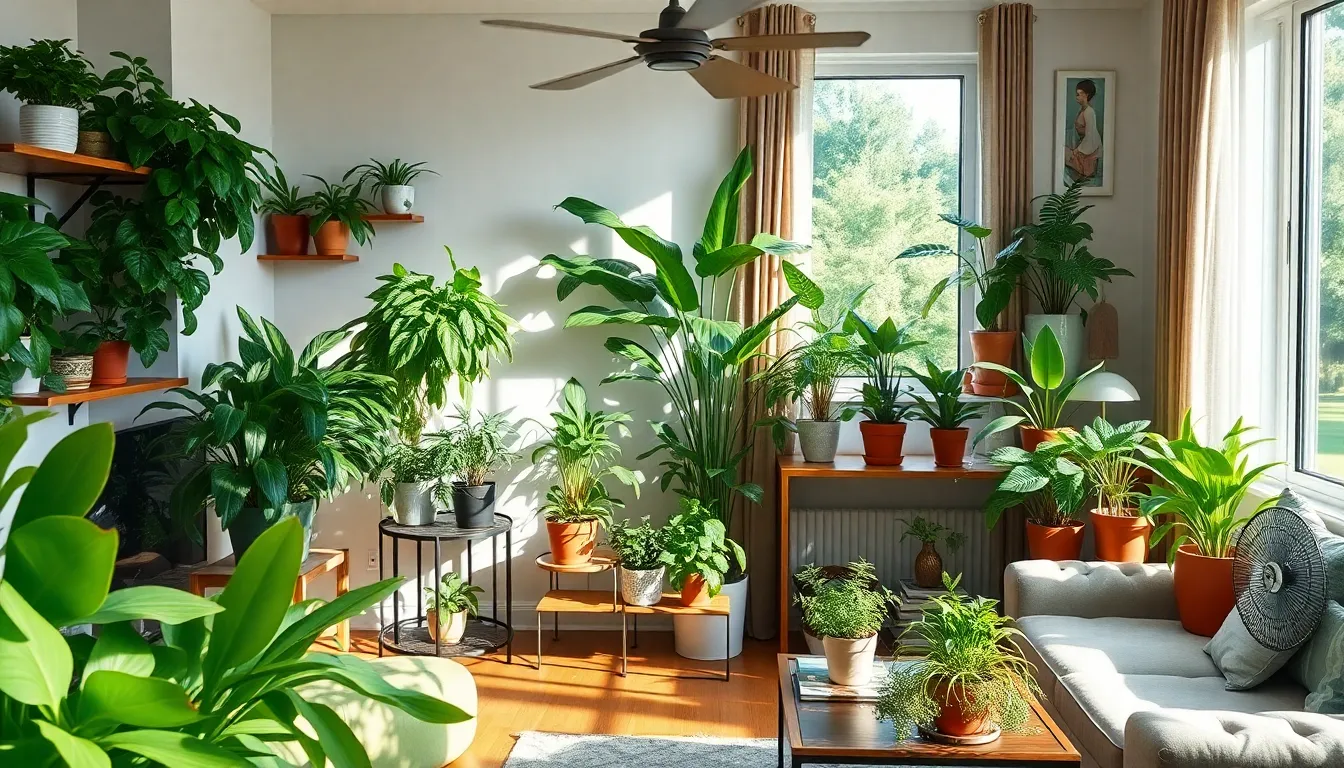
Even our most beautiful plant collections can face challenges that test our green-thumb skills. We’ll walk through practical answers to overcome the most common issues that arise when maintaining living room plants.
Address Low Light and Air Circulation Issues
Identify stretched, thin stems reaching toward light sources as the first sign your plants aren’t getting adequate illumination. Plants developing weak, uneven growth on one side indicate they’re desperately searching for better lighting conditions. We recommend placing struggling plants near windows with natural sunlight or supplementing with grow lights to boost their light exposure.
Rotate your plants regularly to ensure all sides receive equal light distribution and prevent lopsided development. Quarter-turns every week keep growth balanced and maintain the attractive, full appearance we want in our living room displays.
Improve airflow around your plants when you notice increased humidity levels that encourage fungal diseases. Poor air circulation creates perfect conditions for powdery mildew, which appears as white powdery growth on leaves and stems. Opening windows, positioning fans nearby, or relocating plants to less crowded areas dramatically improves air movement and reduces disease risk.
Treat fungal issues promptly with appropriate fungicides when prevention methods aren’t enough, but always ensure plants receive adequate water after treatment to support their recovery.
Manage Pet Safety and Plant Toxicity Concerns
Choose pet-safe plant varieties when cats or dogs share your living space to prevent accidental poisoning from toxic houseplants. Many common indoor plants pose serious health risks to our furry family members if ingested.
Research each plant’s toxicity level before bringing new additions into your home, consulting botanical resources or veterinary guides for comprehensive safety information. Spider plants, Boston ferns, and parlor palms offer excellent pet-friendly alternatives to potentially dangerous species.
Position plants out of pets’ reach when you can’t resist keeping certain varieties that might pose risks. High shelves, hanging planters, and elevated plant stands create barriers between curious pets and potentially harmful foliage.
Monitor your pets’ behavior around new plants during the first few weeks to ensure they’re not showing interest in nibbling or playing with leaves and stems.
Handle Space Limitations and Overcrowding
Select appropriately sized plants for your available living room space to prevent overcrowding that reduces airflow and increases pest and disease problems. Cramming too many plants into confined areas creates unhealthy growing conditions for your entire collection.
Use vertical growing answers like wall-mounted planters, hanging pots, and tall plant stands to maximize your plant display without sacrificing floor space. These approaches create layers of greenery while maintaining adequate spacing between individual plants.
Plan your plant spacing to allow proper air circulation and light penetration throughout your collection. Each plant needs breathing room to thrive and contribute to your living room’s overall aesthetic appeal.
Reassess your collection regularly and relocate or rehome plants that have outgrown their designated spaces, ensuring your remaining plants have room to flourish and maintain their health.
Conclusion
Creating a plant-filled living room transforms your space into a vibrant sanctuary that benefits both your physical and mental well-being. We’ve explored everything from selecting the right plants for your exact conditions to arranging them for maximum visual impact.
Remember that success comes from understanding your space’s unique needs and choosing plants that thrive in those conditions. Whether you’re working with bright windows or darker corners there’s always a perfect green companion waiting to enhance your home.
The journey of living with plants is ongoing and rewarding. As you gain experience you’ll develop an intuitive sense for what works best in your space. Start small embrace the learning process and watch as your living room becomes a lush haven that reflects your personal style while bringing nature’s calming presence indoors.
Frequently Asked Questions
What are the benefits of adding plants to my living room?
Plants offer multiple benefits including air purification, mood enhancement, and stress reduction. They serve as natural décor elements that create a peaceful atmosphere while improving indoor air quality. Plants also add visual interest, color, and texture to your living space, making it more inviting and stylish.
Which plants are best for low-light living rooms?
ZZ plants, peace lilies, snake plants, and pothos are excellent choices for low-light conditions. These hardy varieties can thrive in darker corners and require minimal maintenance. They’re perfect for rooms with limited natural light or north-facing windows.
How should I arrange plants for maximum visual impact?
Use the “rule of three” by grouping plants in odd numbers with varying heights. Create clusters of different sizes and textures, place large plants in corners as anchor points, and add smaller plants on shelves. Mix upright and trailing varieties to add layers and movement.
What type of planters should I choose for my living room décor?
Select planters that complement your existing décor style. Use sleek minimalist containers for modern spaces and vintage or textured pots for eclectic designs. Ensure proper drainage with layered systems and choose sizes that support plant growth while fitting room proportions.
How often should I water my living room plants?
Watering frequency depends on plant type, season, and room conditions. Most houseplants need water when the top inch of soil feels dry. Establish a consistent schedule, typically every 7-10 days, but always check soil moisture first to prevent overwatering.
Can I have plants if I have pets?
Yes, choose pet-safe varieties like spider plants, Boston ferns, or parlor palms. Avoid toxic plants such as peace lilies, snake plants, and pothos if you have curious pets. Research each plant’s toxicity level and consider elevated placement to keep plants out of reach.
How do I deal with limited space in my living room?
Utilize vertical space with hanging planters and wall-mounted containers. Choose compact varieties and use plant stands to create levels. Consider trailing plants that cascade from shelves or tall, narrow plants that don’t take up much floor space.
Should I rotate my plants, and how often?
Yes, rotate plants weekly or bi-weekly to ensure even light exposure and balanced growth. This prevents plants from leaning toward light sources and maintains their shape. Regular rotation also helps you monitor plant health and spot any issues early.

